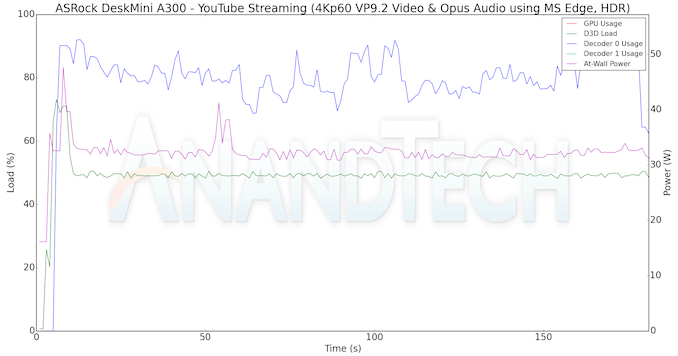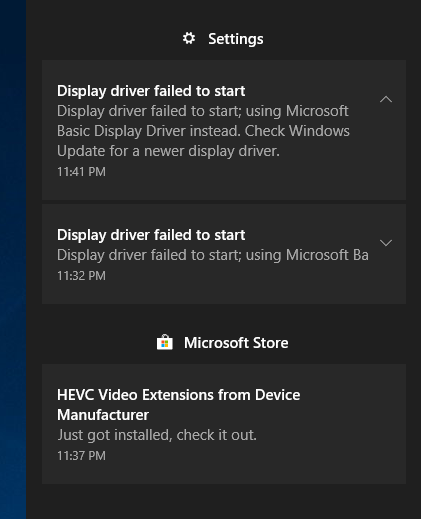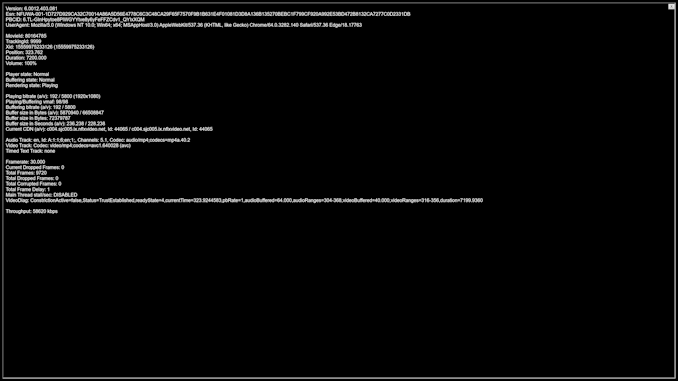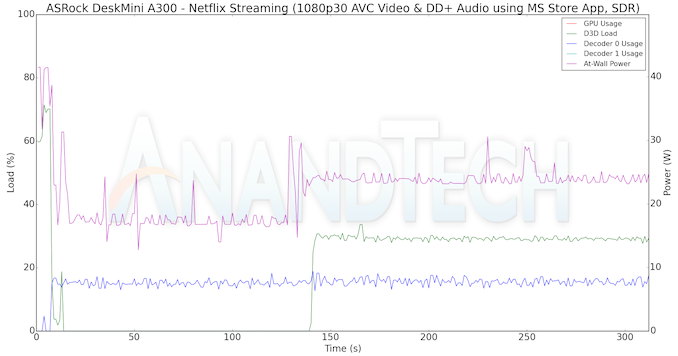The ASRock DeskMini A300 Review: An Affordable DIY AMD Ryzen mini-PC
by Ganesh T S on April 26, 2019 8:00 AM ESTHTPC Credentials - YouTube and Netflix Streaming
Streaming of 4K OTT content with YouTube and Netflix has become mainstream. HDR displays have also started becoming affordable. In order to evaluate YouTube HDR streaming support, we have the Mystery Box's Peru 8K HDR 60FPS video as our test sample. On PCs running Windows, it is recommended that HDR streaming videos be viewed using the Microsoft Edge browser after putting the desktop in HDR mode.
HDR content on YouTube is encoded exclusively in VP9 Profile 2. On systems supporting hardware accelerated decoding of VP9 Profile 2, Edge streams and decodes the HDR stream. The DeskMini A300 passes this test, and we can see HDR YouTube videos, as shown in the picture above.
Various metrics of interest such as GPU usage and at-wall power consumption were recorded for the first four minutes of the playback of the above video. The numbers are graphed below.
Decoding 4Kp60 VP9 Profile 2 videos consumes between 70 and 90% of one of the decoder engines. We also see some Direct3D loading of the order of 70% initially (when the stream being played back is at a lower resolution and needs to be upscaled to 4K). Once the stream stabilizes and the system starts decoding the 4K stream, the Direct3D loading settles around 50%. The average at-wall power consumption for streaming 4K YouTube HDR videos is around 33W.
4K HDR streaming in Netflix requires support for hardware-accelerated decoding of HEVC Main 10 videos. Microsoft removed the in-built HEVC decoding capabilities of Windows 10 in the 2017 Fall Creators Update, and replaced it with an extension that had to be downloaded from the Microsoft Store. Without the extension, playback is restricted to 1080p non-HDR streams encoded in H.264. In addition to the decoding capabilities, the system also needs to support PlayReady 3.0 DRM. In our tests with the Radeon 19.4.2 driver release, we ran into major problems.
Our usual testing flow involves the installation of the HEVC Video Extensions and the Netflix apps from the Microsoft Store. After configuring the Netflix login credentials, we attempt to play back Season 4 Episode 4 of the Netflix Test Patterns title. Unfortunately, the DeskMini A300 behaves in an unexpected manner when subject to the above steps. As soon as the playback of the title starts, the screen goes blank and the display driver crashes.
Windows reverts to the basic display driver, and the Netflix title continues to play back. However, instead of the expected 4Kp60 HEVC Main 10 stream (with HDR), we only get a 1080p30 AVC stream. In order to prevent the crashing of the driver in the course of our evaluation, we opted to uninstall the HEVC Video Extensions app, and make use of only the AVC decoder built into Windows. Without the HEVC Video Extensions, the driver has no problem with standard 1080p Netflix streaming. The OS screenshot facilities obviously can't capture the video being played back. However, the debug OSD (reachable by Ctrl-Alt-Shift-D) can be recorded.
The (avc) entry corresponding to the Video Track in the debug OSD, the Framerate (30.000), and with the A/V bitrate details (192 kbps / 5800 kbps) indicate that we are only getting a low quality 1080p stream compared to the best available one (4Kp60 16 Mbps HEVC Main 10 HDR stream). Similar to the YouTube streaming case, metrics such as GPU usage and at-wall power consumption were recorded for the first three minutes of the playback of the title. The numbers are graphed below.
1080p30 AVC playback is a walk in the park for modern computing systems. We see that the Direct3D loading is only around 30% and the decoder usage is less than 20% in the steady state. The former is mainly due The at-wall power consumption is around 24W for this workload.















88 Comments
View All Comments
Thvash - Friday, April 26, 2019 - link
For some reason 4K HDR, VP9 Profile 2 is not accelerated at all under Windows, while GPU claims to support it, no such issues under LinuxSmell This - Friday, April 26, 2019 - link
**Microsoft removed the in-built HEVC decoding capabilities of Windows 10 in the 2017 Fall Creators Update, and replaced it with an extension that had to be downloaded from the Microsoft Store. Without the extension, playback is restricted to 1080p non-HDR streams encoded in H.264. In addition to the decoding capabilities, the system also needs to support PlayReady 3.0 DRM.**______________________________________
Ding!
Another drive-by DRM borking by WIntel ...
Ratman6161 - Monday, April 29, 2019 - link
This doesn't come with an OS, so if you hate Microsoft so much, then don't use Windows. As far as DRM goes, support for it is a necessary evil to avoid being sued. So it's not a "borking by Wintel", its a symptom of our lawsuit happy society + rampant piracy that the owners of intellectual property feel they must defend themselves against.mapesdhs - Thursday, May 2, 2019 - link
Wow, talk about buying MS' spin. Amazing how people are so happy to throw away their freedoms. In reality the blatant abuse of consumer IP rights is far more important but rarely addressed.https://www.youtube.com/watch?v=tUAX0gnZ3Nw
peevee - Thursday, May 2, 2019 - link
"In reality the blatant abuse of consumer IP rights"You have NO rights to OTHER PEOPLE'S Property. Intellectual or not.
ripbeefbone - Thursday, May 2, 2019 - link
I miss the 90s when nerds weren't embarassing bootlickers who fawned over corporations. get a soul you shillspeevee - Monday, May 6, 2019 - link
I was the nerd in the 90s (and 80s) and still supported patents and copyrights. While violating some of them.airider - Thursday, May 2, 2019 - link
Interesting perspective. Intellectual property is not defined anywhere. It is a made up term assigned to copyrighted material and patents. If you live in the U.S. these are protected by Article 1, Section 8, Clause 8 of the Constitution:“To promote the progress of science and useful arts, by securing for limited times to authors and inventors the exclusive right to their respective writings and discoveries.”
The "right" to IP is only guaranteed for a limited time. When this time expires, the "right" no longer exists and it becomes public domain.
airider - Thursday, May 2, 2019 - link
In fact, the reason these legal definitions exist is because copyright material and patents are not property, but rather the expression of ideas and thoughts through various forms of media (i.e. verbal, visual, etc).Because expressions are not property, a legal construct was created in order for "expressionists" to protect their ability to "make money", since once they expressed themselves, the expression is no longer their own, and the ability to profit was no longer in their control.
sorten - Tuesday, May 21, 2019 - link
I was also a nerd in the 80's (and still today) and have never thought it was cool to steal others' creations. If you do that on a large enough scale then there's no incentive left for creative types to create, and what a unhappy world that would be to create.